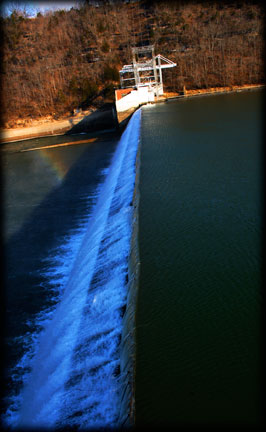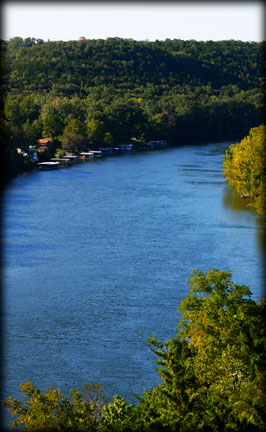The First Lake
Taneycomo & Powersite: 1913
by Joshua Heston
Lake Taneycomo was formed in 1913 when Powersite Dam was built.
Named for its location — Taney County, Mo. — the lake was the first of four resevoirs built to tame the White River.
Memorialized in 1922 (by Ralph Chesley Ott, see painting above), the lake became a favored vacation spot.
The warm, languid 22-mile-long lake made for an inviting tourist destination. On Taneycomo’s shores, the community of Rockaway Beach prospered as a homey resort town.
It was a dramatic step in the Ozarks’ transition from Civil-War- battleground to a “Land of a Million Smiles” — as one of the region’s earliest promotional campaigns touted.
Yet, Powersite Dam did not tame the White River. Heavy floods still occurred, often with devastating results to surrounding communities.
Completion of Table Rock Dam in 1958 finally brought the White River under control.
In doing so, Lake Taneycomo was permanently altered.
Cold water from the depths of Table Rock — a much larger and deeper resevoir — became the older lake’s main water source.
The water temperature of Taneycomo dropped significantly, creating a year-round cold-water lake.
Trout flourished. Swimmers did not. Tourism at Rockaway Beach faltered. And upriver in Branson, tourism grew.
Today the lake is a renowned trout hatchery. And a symbol of the modern-day Ozarks. It is a symbol of just how much we can alter this world around us.
March 30, 20098
Plate 1. Detail from Power from the Hills by Ralph Chesley Ott, 1922. Capitol Building, Jefferson City, Missouri (6/5/08).

Plate 2. Power Site Dam (02/25/09).

Plate 2. Lake Taneycomo from Point Lookout, Hollister (09/15/08).
Highlights, Powersite Dam and Lake Taneycomo
Beautiful Taneycomo is 22 miles long and encompasses 2,080 acres of clear water. Set in legendary Shepherd of the Hills Country, the lake is a main artery of Ozark Mountain Country's tourist industry
Powersite Dame Specifics:
- Overall length, 1300 feet
- Length of spillway, 600 feet
- Number of generators, four
- Plant capacity, 16,000 Kilowatts
- Dam constructed in 1913




